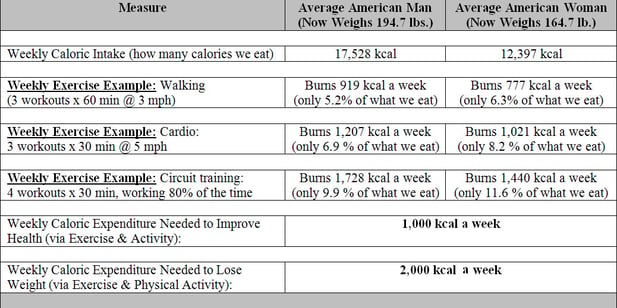We all know a well-structured and consistent exercise program combined with a healthful diet can help all of us shed unwanted pounds and achieve our ideal body type.
But do we need to push ourselves in the gym each day leaving buckets of sweat on the floor? Do we really have to eat foods that taste like cardboard?
No, we don't!
That's where Non-Exercise Activity Thermogenesis (or NEAT) comes into play.
Let’s examine how we can successfully combine everyday activity with diet and exercise to burn calories and lose fat through NEAT.
Table of Contents
What is NEAT?
Non-Exercise Activity Thermogenesis (NEAT) is the energy expended for everything we do that does not include sleeping, eating, or exercise; and ranges from simple things like standing and fidgeting to moving about.
Over the past few years, researchers have begun investigating the remaining 110 – 115 hours of the week that we are awake as a weight loss solution, rather than the few hours a week spent trying to exercise.
The results are impressive. They provide many opportunities to achieve effective and sustained weight loss without complicating our lives, finding more time to exercise, doing things we may despise, or even exceeding our own comfort levels or abilities.
NEAT is not to be confused with METS.
For example:
A 145 lb. person burns approximately 102 calories an hour while performing their office job in a seated position (1.7 kcal / minute), but burns 174 calories an hour if performing those same office duties while standing.
174 calories may not seem like much, but it translates to 18,000 calories or a little over 5 lbs. over a 50-week work year (250 work days). By comparison, that same person would need to squeeze in 60, 30-minute runs at 5 mph to achieve that same caloric burn (2).
Check out this weight loss calculator if you want to make some calculations of your own. The calculator uses basic RMR calculations to arrive at measurable results.
Exercise is Often Not Enough for Weight Loss
Exercise alone is generally inadequate unless one finds more time in an already busy schedule, what other options are available?
The goal is to rethink your approach to where and how you burn calories by making your entire day your weight loss battlefield.
That battlefield is the area we can use to complement the exercise we want to do, and not feel like we have to do. Sitting all day only welcomes weight gain.
So how do we do it then? How do we use NEAT to skyrocket the amount of calories we burn and also speed up our metabolism?
Five Ways to Use NEAT for Weight Loss
-
Create a list of your general daily activities (e.g., 6:30–7:30 am – preparing for work; 7:30–8:00 am – commuting to work; 8:00–12:30 pm – working at desk, mostly seated activities, etc.).
- Are you aware of how many hours you spend sitting each day? Perhaps add here – compare your ratio of time spent doing seated versus standing activities (e.g., 70%:30%)
- Compile a list, the contents may just startle you.
- Are you aware of how many hours you spend sitting each day?
- Compile a list, the contents may just startle you.
- Identify problematic areas where you notice time spent in seated positions and think creatively of ways to accomplish these same activities while standing (e.g., texting, talking on the phone).
- Challenge yourself to try one to three ideas just once, starting with challenges you feel confident in accomplishing.
- Evaluate your experiences, but don’t force things you don’t like. If you enjoyed the experience and feel confident you can do it again. Attempt that same challenge every day for the next week (finite challenge). If not, select new challenges to try.
- As little as 100 calories each day translates to approximately 10½ lbs. lost in a year; 200 calories equals the loss of 21 lbs.
See also for tips on how to SPEED up metabolism.
Try these practical steps for neat:
- Stand more. Start by attempting to stand or move about for 5 to 10-minute increments while you complete various daily activities.
- Wash your car by hand.
- Pace the sidelines at your kids' athletic games.
- Carry your groceries instead of pushing a cart.
- Walk briskly through the mall. Walking is an excellent strategy for weight loss!
- Take the long way to the water cooler or bathroom at the office.
- Walk to a co-worker's desk instead of emailing or calling them.
- Pace while talking on the phone.
Find ways to integrate standing and moving activities – a little here and there. Remember, every little calorie counts throughout your day; every little victory moves you forward.
As little as 100 calories each day translates to approximately 10 lbs. lost in a year; 200 calories equals the loss of 20 lbs., without even breaking a sweat. By comparison, 10 lbs. for a 145 lb. person requires almost 120, 30-minute cardio sessions at 5 mph.
So, add these NEAT calories to an exercise plan you find manageable and enjoyable, and you’ll enjoy greater success in achieving your weight loss goals.
Read also: How to Lose Weight Fast
Using Exercise and NEAT together
Exercise and improving overall fitness is vitally important to your health and wellness, as well as your ability to engage in normal activities of daily living (ADLs).
Some benefits of exercise include a stronger more efficient heart, reduced risk of heart disease and diabetes, stronger muscles and thicker bones, reduced cholesterol levels, and improved mental health.
However, some individuals believe that just two to three workouts a week will magically shed unwanted pounds from their bodies. Unfortunately these same individuals then become frustrated when it does not happen.
Although exercise is vital to our overall quality of life, it is important to understand how exercise impacts weight loss, especially for those just starting a weight loss program. The table presented below provides information on the calories burned through several different types of exercise programs in comparison to the total number of calories we eat each week (1, 2).
We need to burn 2,000 calories each week through physical activity in order to lose weight (3). So, unless your plan involves numerous high-intensity exercise sessions each week, it is unlikely that you’ll achieve your weight loss goals through exercise alone.
Dieting and NEAT: They Still go Hand-in-Hand
Consequently, many of us turn to diets as our solution, but it is important to consider the following facts before making such a decision:
A strong motivator of human behavior is the right to choose. When we start to reduce our normal daily caloric intake by more than 30%, we start to consciously feel deprived of food and choices. Deprivation frequently results in failure to adhere to diet programs for sustained periods of time (4).
Reductions of approximately <20% however can usually be implemented without such deprived feelings.
Also, an easy way to lose weight is to eat foods that facilitate weight loss. Check out this blog on foods for weight loss for more information.
Counteract Muscle Loss
As we age we lose muscle tissue which reduces our ability to function independently. It is estimated that a woman between the ages of 30 and 70 may lose as much as 23% of her muscle tissue whereas a man may lose up to 21 – 22% of his muscle mass during that same time period.
In turn, this loss generally compromises our quality of life, progressively preventing us from doing the things we enjoy or need to do as we get older.
Choosing to follow a diet without any activity, movement or exercise plan can certainly lead to initial weight loss, but for every pound lost, a good estimate is that up to 69% of that pound could originate from fat tissue, whereas the remaining 31% could originate from the loss of muscle tissue, something we should all try to avoid (5). This skinny fat approach is certainly not a healthy solution.
Including some form of cardio activity to complement your dietary strategies can also help you lose weight, but again for every pound lost, up to 78% of that weight will originate from fat tissue, whereas the remaining 22% could originate from muscle tissue (5).
However, including some form of resistance training (weights, machines, yoga, etc.) on the other hand is the most effective weight loss method as it can preserve almost all your existing muscle up to 97 % of the weight loss can originate from fat tissue (5), keeping you ‘fit, healthy and functional.’
Furthermore, by preserving or even adding a few pounds of muscle tissue, you can maintain or even elevate your metabolism which helps you burn additional calories through the day. This number could amount to 100 calories each day, the equivalent to approximately 10 pounds over the period of one year
See also: Use it or Lose it: Understanding Muscle Atrophy | Combating Age-Related Muscle Loss
References:
- NHANES, 2008. Trends in intake of energy and macronutrients in adults from 1999-2000 through 2007-2008. NCHS Data Brief. Number 49, November 2010. http://www.cdc.gov/nchs/data/databriefs/db49.htm; retrieved 09/01/12.
- Ainsworth, BE, Haskell, WL, Herrmann, SD, Meckes, N, Bassett, DR, Tudor-Locke, C, Greer, JL, Vezina, J, Whitt-Glover, MC, and Leon, AS, (2011). 2011 compendium of physical activities: a second update of codes and MET values. Medicine and Science in Sports and Exercise, 43(3):1575-1581.
- American College of Sports Medicine (2014). ACSM’s Guidelines for Exercise Testing and Prescription (9th Edition). Baltimore, MD: Lippincott, Williams and Wilkins.
- Wansink, B, (2006). Mindless Eating – Why we eat more than we think. New York, NY: Bantam-Dell Books.
- Stiegler, P, and Cunliffe, A, (2006). The role of diet and exercise for the maintenance of fat-free mass and resting metabolic rate during weight loss. Sports Medicine, 36(3): 239 – 263.

















